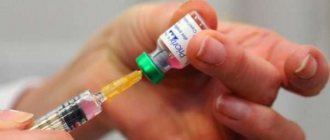There is a group of diseases that people suffer mainly in preschool age. These are the so-called childhood infections: chickenpox, diphtheria, whooping cough, measles, rubella, polio, mumps, scarlet fever. In recent years, thanks to vaccination, outbreaks have rarely occurred in kindergartens and schools. Vaccination, which targets measles, rubella and mumps, allows people in older age, if not to avoid infection, then at least to prevent the severe course of these serious diseases.
A little about the diseases themselves. Why are they dangerous?
The MMR (measles-mumps-rubella) vaccine contains designated weakened viruses and stimulates the body’s defenses, forcing it to independently develop means of combating “imposed” invaders. By coping with them, the child receives lasting immunity against measles, rubella and mumps. Many people do not take “childhood illnesses” seriously, but these are dangerous infections, the consequences of which are serious. Neuritis with progressive deafness and blindness, damage to the meninges are only a small part of the complications of the described viral diseases.
Only humans can spread and transmit the disease. The more people who receive MMR vaccination, the fewer viruses will circulate, and perhaps future generations will no longer hear about these infections.
Now, according to statistical studies, the risk of infection of an unvaccinated person when meeting with a carrier of the causative agent of measles is 95%, rubella – 98%, mumps – 40%. These infections are dangerous due to such severe complications.
- The worst thing is that a baby can suffer from the effects of viruses before it is even born. This happens if a pregnant woman becomes infected. Intrauterine infection provokes multiple abnormalities: deafness, heart disease and even fetal death.
- Mumps causes inflammation of the membranes of the brain and glands (salivary, pancreas, testes). It is especially dangerous for boys aged 12-16 years, as it causes orchitis, the consequence of which is infertility. Pancreatitis, nephritis and arthritis are also complications of mumps, although they are rare.
- Measles viruses sharply reduce immunity and provoke diseases of internal organs: hepatitis, inflammation of the brain (panencephalitis).
Incubation period and symptoms
All three diseases are related to viral infections, the mode of transmission is airborne droplets, the source is a sick person. After an illness, lifelong immunity is formed, but each of them has its own distinctive features.
Measles
The period from infection to the appearance of the first signs is 1-2 weeks. Infectiousness is established before the 4th day of the rash; after the 5th day the person is considered non-infectious.
- The disease begins with a rise in temperature to low numbers, cough, and possibly a runny nose.
- Somewhat later, the eyes become inflamed with the development of conjunctivitis.
- On the 25th day, a small rash appears on the inner surface of the cheeks. Then the spots spread to the skin, appearing first behind the ears, then on the lower part of the body. The rash is bright scarlet in color, and as a new one appears, temperature fluctuations are possible. Leaves behind a slight pigmentation.
- Complications include otitis media, blindness, and encephalitis.
Rubella
Transmission is possible during pregnancy; if infected in the first three months, it results in stillbirth. The period before the first clinic appears is 16-20 days. The infectious period is 1 week before the appearance of the rash and 5 days after, with congenital rubella up to 21 months.
- It appears as small pinpoint rashes on the face and scalp, gradually going down. Typical lesions are the buttocks, back, front thighs and arms, palms and soles are not affected.
- Characterized by lethargy and rising temperature.
- Congenital rubella manifests itself in a typical triad: cataracts, heart damage and deafness.
- Complications in the form of severe disease, in adults – encephalitis.
Mumps (mumps)
The period from the moment of entry of the pathogen to the first clinic is 14-20 days. The spread of pathogens continues 3 days before the onset of symptoms and until the 11th day of illness.
- It begins with an increase in temperature to various levels.
- Gradually, damage to the parotid salivary gland develops, which manifests itself as painful swelling. The swelling can vary in size. The skin over it does not fold, and dry mouth develops due to impaired flow of saliva.
- Complicated mumps is characterized by the development of heaviness and pain in the abdomen, damage to the nervous system (meningitis, encephalitis).
Is it worth getting vaccinated?
The World Health Organization has developed a strategy to combat infections that can be controlled. They are blocked by vaccinations. Widespread vaccination helps reduce infection to a minimum. For viruses of the CCP group, preventive vaccination is a tool for limiting their spread, and therefore the likely consequences of disease.
Statistics speak volumes about the importance of vaccinations. Every year, 165,000 adults worldwide die from measles. Vaccination of children is currently a hotly debated topic. Opponents are afraid of post-vaccination side effects, but even they understand that this is a good chance to protect children from health problems in the future.
Indications
The current vaccination calendar establishes the procedure for vaccinating children against MMR twice: a year (when the mother’s antibodies have already disappeared) and at 6 years of age (before starting school). Immunization is indicated:
- children 15-17 years old and adults under 35 years old who have not had these diseases and who have not previously received the vaccine. The instructions prescribe double vaccination, the minimum interval between vaccinations is 3 months;
- Vaccinated persons receive revaccination once;
- persons who had contact with sick people - unvaccinated, not sick, vaccinated once. No age limit.
Contraindications for immunization
The measles-rubella-mumps vaccine has contraindications.
Permanent contraindications are pathologies and conditions in which vaccination is prohibited:
- acute allergic reaction to previously administered vaccines;
- oncology;
- egg white intolerance.
Temporary contraindications, in which the introduction of the vaccination drug is postponed for some time:
- the patient is undergoing chemotherapy;
- colds and exacerbation of chronic diseases;
- the patient was injected with blood components (vaccination is done after 3 months).
Schedule and location of administration (where vaccines are given)
Vaccination is regulated by a strict schedule established by the Ministry of Health. Most often, a combined vaccine composition is used, which forms protection against three diseases at once. The vaccination calendar is as follows.
- Babies are vaccinated for the first time at 1 year of age, since at this time maternal antibodies completely disappear from their blood, and the influence of viruses is especially destructive for children who have not reached the age of five.
- The rubella-measles-mumps vaccine is a three-component vaccine that does not give a 100% result when administered once. Therefore, a second injection is given when the child reaches the age of six. At this stage, a full-fledged immune barrier to infections is formed, which will protect a person for several decades in almost 90% of cases.
Medical statistics do not contain accurate data on how long the MMR vaccine remains effective. Depending on the characteristics of the human body and its susceptibility to the drug, it is believed that, on average, it lasts from 10 to 25 years.
If, for health reasons, the child was not vaccinated on time, there is nothing critical about it. Vaccination will be carried out later at a time closer to the established schedule. Even if the baby is vaccinated at 2 years old, a second injection will be possible after 4 years, and this is strictly observed.
Contraindications to vaccination measles-rubella-mumps
Contraindications to immunization against measles, rubella, and mumps include the following:
Temporary contraindications:
— acute periods of illness, until the condition stabilizes; - pregnancy, can be administered immediately after childbirth; - administration of various blood products, for example gamma globulin, it is necessary to refrain from vaccination for 1 month; - interaction with tuberculosis vaccine. The live measles vaccine may be interfered with by the TB test, so the two processes should be performed at least 4 to 6 weeks apart. There is no evidence that the vaccine has a negative effect on the development of tuberculosis.
Permanent contraindications for which vaccination cannot be done at all:
- allergic reaction to neomycin, kanamycin, gentamicin; - allergy to egg whites; - severe allergic reactions, such as Quincke's edema; — presence of neoplasms; - severe reaction or complication to a previous dose of the vaccine; - low platelet count; - some people are HIV-infected; - people with a damaged immune system (for example, after organ transplantation).
How to prepare for vaccination
It is better to prepare for the procedure in advance so as not to “earn” complications that arise after the measles-rubella-mumps vaccination. Preparation is rather preventive in nature and means following a few simple rules.
- In the morning before the procedure, you should check the child’s general well-being, examine him and measure his temperature.
- Pay a visit to the doctor, and it is better to avoid waiting in a long line where there may be sick or infected children. During this time, if possible, let the baby spend time outside with the other parent, grandparents, brothers, sisters, and so on.
- Children with unstable mental health or chronic diseases of the nervous system should be specially prepared to perform such injections. It is necessary to show the child to a neurologist; he may need to be prescribed anticonvulsants.
- Chronically ill children who are forced to constantly take special medications are vaccinated during a period of stable remission.
- On the eve of the procedure, it is better to avoid visiting crowded places with your child, especially in the midst of epidemics.
Measles-rubella-mumps vaccination for adolescents and adults
General recommendations for MMR vaccination in adults are as follows:
most people born before 1957 have been exposed to these once common childhood diseases and do not currently require vaccination; All unvaccinated people born after 1956 who no longer have measles and mumps should be given two doses of live measles-rubella-mumps vaccine given at least 1 month apart (adolescents) or one dose (adults).
Immunizing adolescents can achieve several positive results:
— Protection against rubella for girls, who in the majority in the next 5–10 years will bear and give birth to children for whom the rubella virus is dangerous. — Development of immunity against measles, which will meet the vaccine virus and receive stimulation. — Protection against mumps for young men who are at the most dangerous age in terms of the negative consequences of mumps, and in particular the transfer of these infections can negatively affect reproductive health and subsequent offspring
Scheme of implementation
Routine vaccination is carried out for children who have never had mumps and measles (at 12 months and 6 years). It is important that at least 80% of the team should be immunized against mumps, since a smaller percentage of children vaccinated against infection will lead to a shift of infection towards older age groups (13-15 years).
Planned and emergency prevention is provided by a vaccine that stimulates the production of antibodies to mumps and measles viruses - mumps-measles cultural live. The maximum concentration of antibodies to measles is achieved after 3-4 weeks, mumps - after 6-7 weeks.
The mumps-measles live vaccine must be prepared only before the injection itself. For one injection, 0.5 ml of solvent is used, the substance is injected into the shoulder area or under the shoulder blade.
How many times do they do it
The number of injections performed during vaccination is determined by the relevant provisions: instructions for the use of drugs for children from 1 year to 18 years, instructions for the use of vaccines for children aged 15-17 years. The number of vaccinations and their timing, as well as the reasons why they are given, is reflected in the table.
| Type of vaccination against | Start of vaccination | First revaccination | Note |
| Measles, rubella, mumps | At 12 months | At 6 years old | – |
| Rubella | At 13 years old | – | The child did not have rubella or was not vaccinated, or was vaccinated once |
| Corey | At 15-17 years old | – | The child did not have measles, was not vaccinated, was vaccinated against measles only once, there is no information about vaccinations |
Possible complications
It is extremely important that serious complications occur after immunoprophylaxis. As a rule, they are caused by the use of a low-quality drug, non-compliance with the technique of administering the medication, and neglect of medical recommendations.
Also, the consequences of vaccination are noted if the procedure was performed in the presence of contraindications.
Possible negative changes:
- Quincke's edema;
- convulsive syndrome;
- anaphylactic shock;
- hyperthermia;
- glomerulonephritis;
- thrombocytopenia;
- toxic shock;
- loss of consciousness;
- serous meningitis;
- breathing problems;
- encephalitis of post-vaccination type.
If such changes occur, you should consult a doctor immediately.
Rash after immunization
The appearance of a rash after vaccination is observed in five out of a hundred children. Rashes can occur in a small area or spread widely.
Pale pink spots with a small diameter are found on the face, neck, arms, back, buttocks, and behind the ears. Sometimes the color of the rash is no different from the normal skin tone.
There is no reason to fear. The appearance of a measles-like rash indicates the active synthesis of antibodies to measles. There is no need for treatment. Soon the unpleasant symptoms will disappear on their own.
How long does the temperature last
The temperature may rise for 6-12 days after vaccination. Often, high thermometer readings are observed for only two days. Rarely do negative changes last up to five days.
Associated symptoms may include chills and aches.
It is recommended to give your baby antipyretics based on Paracetamol and Ibuprofen.
If your child gets sick after vaccination
As a rule, the development of disease after vaccination is random. This is just a coincidence, there is no connection with the introduction of serum.
Most often, the onset of the pathological process is accompanied by an increase in temperature and signs of intoxication. Naturally, parents perceive such symptoms as consequences of immunization. In this case, the diagnosis is not made in a timely manner.
If your baby begins to show signs of illness, you should immediately contact your pediatrician. With its help, it will be possible to determine what caused the symptoms (developing disease, post-vaccination complications).
If the cause of negative changes is ARVI or any other pathology, appropriate treatment is immediately prescribed. If complications develop after the injection, therapy is aimed at eliminating the symptoms. Antihistamines and antipyretics are used.
Types of vaccines used
The type of drug is determined by the type of weakened viruses included in it. All used compositions form stable immunity to typical viruses and activate resistance to them with a high probability. WHO rules require interchangeability of formulations, that is, children can be vaccinated with different drugs and get equally good results.
MMR vaccination can be three-component, dicomponent and monocomponent. A three-component vaccine is a ready-made complex containing weakened rubella, measles and mumps viruses. The vaccine contains two components; these can be measles-rubella combinations or a measles-mumps vaccine without rubella viruses. A monovaccine acts against a single infection, for example, measles. Vaccination with a three-component vaccine allows you to visit the doctor once and get only one injection. A dicomponent vaccine requires an additional injection of the missing monovaccine, for example, rubella-mumps must be supplemented with an anti-measles drug. Ingredients from different ampoules absolutely do not mix, so you will have to give a second injection.
Domestic
Our country does not produce a three-component vaccine. Dicomponent is produced on the basis of quail egg proteins. In medical institutions, only the drug rubella-mumps is used, which requires the additional administration of a vaccine with measles viruses. The domestic drug is inferior to foreign analogues only in this regard.
Imported
Among imported vaccines, a Belgian drug called Priorix is in good standing among pediatricians. The vaccine is intended to prevent all three infections simultaneously: measles, mumps and rubella. Has a combined effect. So, if a child or adult has suffered from measles and mumps, but they do not have immunity to rubella, then the drug may well act as a universal vaccine - rubella-mumps-measles cultural live. This stimulates the development of immunity to the new virus present in the vaccine.
Other imported vaccines are also used:
- against measles, mumps and rubella - MMR (Holland-USA);
- against rubella - Ervevax (England).
They are most often not available in clinics, so if you want to use them, you will have to buy the drugs at your own expense. When purchasing independently from a pharmacy, it is important to check the conditions of transportation and storage of ampoules.
Which vaccine is better
It is difficult to talk about the advantages of domestic or imported vaccines. Of course, an imported three-component drug is more convenient in the sense that you can be vaccinated against three infections at once. The Russian vaccine requires additional administration of the missing component. But it is always available and free. The reaction to domestic and imported measles-rubella-mumps vaccination will be the same.
What not to do after vaccination
Normal complications following a PDA injection are similar to common cold symptoms. In order not to confuse an acute respiratory infection with a reaction to a vaccination, you must carefully monitor the condition of the vaccinated child and follow a number of rules.
- Do not leave the medical facility for half an hour after the procedure.
- It is better not to bathe your child on the day of vaccination. On this day you can get by with a light shower. Do not rub the injection site with a sponge.
- To avoid allergic reactions, you should not introduce new foods into your child’s diet.
- Walking in the fresh air is quite acceptable, but it is better to avoid visiting crowded places, including playgrounds, so as not to “catch” the infection.
- It is very important to be prepared for the possible consequences of vaccination and to discuss possible scenarios with your pediatrician in advance.
How is vaccination tolerated by children of different ages?
Children undergo vaccination and revaccination at different ages, respectively, and their bodies react to them differently, although there are common symptoms. Thus, elevated temperature after MMR vaccination is a normal sign for all groups of patients.
Normal reaction
In one-year-old children, the reaction to the vaccine resembles the symptoms of a common cold. The following symptoms are considered normal:
- poor sleep and appetite;
- weakness;
- runny nose;
- headache;
- rashes;
- redness in the throat;
- hyperemia and swelling at the injection site.
Children as young as six years old experience similar symptoms. But they may additionally develop an allergic rash in the injection area, cough, otitis media and bacterial sore throat.
Possible complications
Complications are rare. It is important not to confuse these with normal side effects. If you do not seek medical help on time, there is a possibility of developing the following conditions:
- intense allergic manifestations - urticaria, swelling, anaphylactic shock. The vaccine contains antibiotics and egg protein, which can cause allergies. Deciphering the patient's pre-test data will help identify the allergen;
- pneumonia;
- encephalitis. Typical for children with diseases of the nervous system, they occur in one in 100 thousand people;
- myocarditis;
- change in blood composition.
Is it possible to get the measles-rubella-mumps vaccine if you have a runny nose?
If the symptoms of a cold are pronounced, it is better not to vaccinate. A weakened immune system may not be able to cope with even a lighter version of viruses, so it is better not to take risks. The presence of a slight runny nose is not a strict contraindication for the procedure. The decision should be made by parents after consulting with a pediatrician.
Is a child contagious after vaccination?
The vaccine contains weakened viruses that are not able to “trigger” the disease. The presence of a post-vaccination reaction in the body is not a cause for concern; the baby will not become a carrier of the infection and will not be contagious. Symptoms of malaise are a sign that his immune system is working to develop mechanisms to combat “unwanted guests.”
Specifics of diseases
Measles is transmitted through airborne droplets. At first, the disease resembles an ordinary respiratory infection, but upon examination, rashes are observed on the buccal mucosa. Further, the patient develops complications - elevated temperature, as well as the gradual formation of a rash on all parts of the body. Adults are also susceptible to infection, most often those who were not vaccinated as children.
In mild forms, measles can be cured without consequences. But when complications arise, it turns into a very serious disease that can be fatal. These complications include encephalitis, frequent diarrhea, ear inflammation, and the biggest risk is pneumonia.
Rubella is also most often transmitted through the air. Complications usually do not appear, but encephalitis sometimes occurs. The disease is very dangerous during pregnancy; it can contribute to miscarriage or intrauterine death of the baby. When a baby is born alive, he often develops congenital rubella syndrome. If a woman is suspected of having a disease, she must be examined.
Mumps is an infectious viral disease that is one of the same childhood diseases as rubella, chicken pox, or measles. However, it is not only young children who suffer from these diseases. Adults experience childhood illnesses much more severely. A feature of mumps is that the disease affects the parotid and submandibular salivary glands. Mumps infection is transmitted during conversation, sneezing and coughing.
Mumps has a lower tendency to spread than measles. If you isolate the patient in another room, you can protect other children and adults from the disease. At the onset of the disease, mumps is expressed by malaise, as well as a low temperature. Then the patient’s salivary glands become enlarged, making it difficult to chew and swallow. Complications caused by the disease:
- pancreatitis;
- inflammation of the female and male genital organs, which can cause infertility;
- meningitis;
- sometimes fatal.
Some forms of the disease become very dangerous. This happens when the disease affects the pancreas and nervous system. The result of such mumps can be diabetes mellitus. Mumps, if not recognized in a timely manner, can develop quickly and lead to death. Therefore, doctors are very persistent in the issue of universal vaccination against mumps.
Each of the diseases (measles, rubella, mumps) is caused by viruses for which there are no drugs. Typically, population vaccination is used to combat these diseases.
What to do if side effects occur
After vaccination, the baby should become an object of constant monitoring for parents. Most often, the consequences are caused by the measles component of the vaccine. After five days, the temperature may rise, weakness, rash and sore throat may appear. Adults must react correctly to the situation. Normal side effects are ignored. But if convulsions occur, which means that the inflammatory process has affected the nervous system, you should act quickly and immediately consult a doctor.











